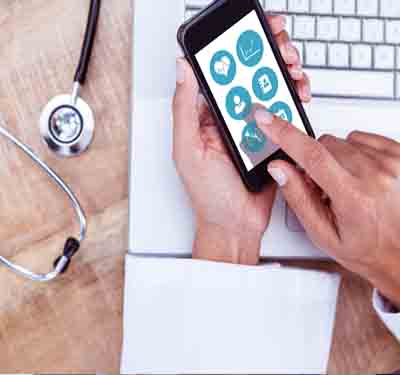Mobile apps in trauma education
Several mobile applications are available as educational tools in the field of pre-hospital trauma life support (PHTLS), but there is room for improvement.
Published online 30 December 2016

Medical apps are becoming popular around the world, but not much is known about how useful they are.
Wavebreak Media ltd / Alamy Stock Photo
Mobile apps are becoming popular educational tools due to their accessibility, interactivity and ability to provide personalised learning. Numerous apps are now available for healthcare professionals, including in the area of medical education and training1. But until now, the number of PHTLS apps available for health professionals or information on their features was not known.
PHTLS is the emergency support provided for trauma patients involving their immediate care and transport. It is indispensable for the early identification and management of life-endangering trauma.
Researchers in Peru conducted a systematic search of the Apple Store, BlackBerry World, and the Google Play Store in December 2015 for all English and Spanish mobile apps that at least provided information on the airway, breathing and circulation (ABC) first-aid procedure for PHTLS2. They found a total of 41 mobile apps.
Less than half these apps were free, among which only a few had interactive content (30%). Also, few of the free apps (30%) were institutionally certified, which means the credibility of their content cannot be guaranteed. An Internet connection was not required for most free apps (85%) to be fully functional, a feature that could be considered useful for professionals working in pre-hospital environments where Internet connections can be weak or unavailable, say the researchers.
The team did not have access to information on PHTLS training apps that cost money, so they were unable to evaluate their features and compare them with those of free apps. Nevertheless, the team believes this to be the first study that has evaluated the features of mobile apps for PHTLS. Designers of these apps, PHTLS professionals and researchers in the field of wireless and mobile technologies in medical care should take the study’s findings into consideration when designing and using them, the researchers conclude in their study published in the Journal of Emergency Medicine, Trauma & Acute Care.
References
- Ventola, C. L. Mobile devices and apps for healthcare professionals: Uses and benefits. P T39,356–364 (2014)| article
- Nieto-Gutierrez, W., Aguirre-Tipismana, L., Torres-Mallma, C., Salazar-Rojas, R. & Taype-Rondan, A. Features of mobile provider education applications for prehospital trauma life support. J. Emergency Med. Trauma Acute Care2016, 12 (2016) | article
DOI: 10.1038/qsh.2017.143

